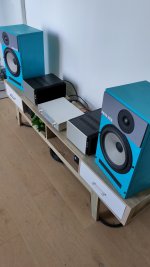No, we do trust our filter.There should be an onboard power line filter on the PSU PCB. Adding a second seems weird. They don't trust there own filter? Power line filters are not just designed to withstand some maximal current but also to preform best at some nominal current. It's not just the fuse that differs. German brand Schaffner is pretty open about there component selection, see page 2 of linked document for some examples.
https://www.schaffner.com/fileadmin/user_upload/pim/products/datasheets/FN9222E.pdf
But for some people adding one with a filter is no problem and has nothing to do with the one on the SMPS.
You can use a high-quality AC socket without EMI filter.
An AC socket with a 6A fuse won't work, because the inrush current is higher than 6A at 120VAC.
COBRA-S2 peaks 1800W output at 240VAC
Thank you
800VA is fine too.Trying to assimilate. Am I correct in thinking a 1K transformer with 2 45 volt secondaries would give me 64 volt rails, and the NJW 0281/0302s would give me 200 watts into nominal 8 ohm speakers which dip to 4 ohms. And that the Diyaudio Store UMS heatsinks are already tapped for those?
Thanks,
Mark
You will be probably closer to 180w as per the table in the 1st post and the second sheet of the BOM if you useca 800VA transformer. 1000VA will probably get you closer to 200w depending on the load and the voltage drop of the transformer.
The rest of what you said is correct.
Is there an advantage to the NJW0281 over the NJW3281 in terms of distortion? I assume the latter also fits the UMS heat sinks?
The UMS heatsink will fit most of the holes but not if you want to use TO-264 outputs, those require additional drilling and tapping. However if you contact Modushop I believe they have a drill pattern for the Wolverine board. You'll have to specify EF3-3 or EF3-4, which ever you ordered.Is there an advantage to the NJW0281 over the NJW3281 in terms of distortion? I assume the latter also fits the UMS heat sinks?
Jeremy
Both my PCB test and measured according to the building guide, right on. Now time to match the output transistors. Great starting procedure btw.
SB
SB
Just in case someone wants to use the ssr based protection boards designed by @LKA and just didn't dare to design his own pcbs to enable the overcurrent protection, I made these tiny overcurrent sensing boards for my Wolverine:


For Gerbers (and also the files you'd need for the assembly by Jlcpcb) just send me a PM.
For Gerbers (and also the files you'd need for the assembly by Jlcpcb) just send me a PM.
Just use a DAC straight in...plenty of gain I control volume through a raspberry pie with squeeze box serverNice setup, is that a diy preamp? Speakers are nice too.
I was all set on the Njw0381, dictated by wanting to avoid tapping heat sinks. Now I’m thinking I may be able to source heatsinks elsewhere. Is anyone willing to take a stab at the subjective differences between those and the “premium” mjl4281?
As stated by John in post #1345, NJW1302G/3281G have better SOA specs and don't need new holes tapping. They perfectly fit UMS requirements. I used them in my build and they work very well. If you feed them with low voltage (no more than +-60VDC), you could drive lower impedance loads.
Gaetano.
Gaetano.
As a newb, I'm struggling with choices. My speakers are 8 ohm, though they dip to 4 ohms in lower frequencies. I want plenty of overhead, good for symphonic music, and a contrast to my class A. I was thinking 71 volt rails, as my speakers are easy to drive, but 64volt rails would allow me to use 80 volt filter caps, which is very attractive. Would 100va , 45 v secondaries and NJW 3281s make sense? Any input is appreciated!
64 volt rails should be good for around 200 watts or a bit more at 8 ohms. If your speakers are "easy to drive", meaning fairly sensitive that should be plenty for classical music, especially since the energy will be at lower frequencies where you say the impedance drops. The transformer is too small VA rating, even for a single channel. I would look at 400-500VA 45-45V for two channels. NJW3281/1302 are a good choice and will fit on the normal UMS heat sink.
Thanks guys - I did mean 1000va 45v x 2 for two channels. Rod Elliott has me convinced that separate transformers is pointless, plus they take up a chunk of space. I guess I thought I needed 71 volt rails, but I get the sense that 64 volts will be plenty and more reasonable to implement.
- Home
- Amplifiers
- Solid State
- DIY Class A/B Amp The "Wolverine" build thread
